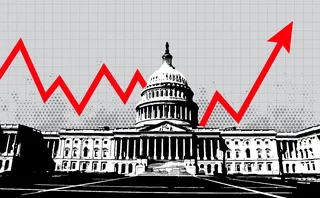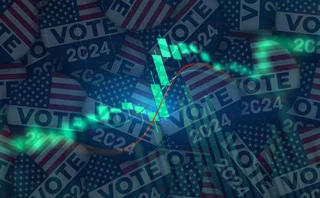
In factor timing, ‘where?’ matters as much as ‘when?’
Goldman quants’ thought experiment shows timing works best for low-Sharpe strategies
Quants have long tried to pinpoint when the factors they work with are primed to crash or surge. Many have sought ways to ‘time’ these switchbacks. Most agree it is hard; some say it can’t be done.
Perhaps, though, quants have been asking the wrong question.
Rather than asking ‘when?’ to time the factors that drive asset returns, researchers at Goldman Sachs quants asked ‘where?’ timing could work.
Nick Baltas and Desi Ivanova from the bank’s systematic trading strategies research team designed a thought experiment to help answer that question. They found the benefits of timing were more pronounced for strategies with lower Sharpe ratios.
Baltas and Ivanova sketched the distribution of returns for two hypothetical strategies in which a manager is able to time the direction of the investment perfectly, eliminating all losses. The distributions appear as conventional bell-shaped curves but with the left side pressed flat (see graph).
It’s clear from comparing them that the higher Sharpe strategy benefits less from timing in relative terms. Intuitively, for the better strategy, there are fewer potential losses to cut out by correctly calling changes in direction.
Of course, returns for real strategies rarely look like a bell curve. Perfect timing would be more valuable for a strategy that loses big every so often. But anticipating such events is hard. And in simulations, the benefits were small, the quants say.
Goldman’s findings on where timing is likely to work best has special relevance today. Several investors are champing at the bit to time the equity value factor – a popular quant factor traded through buying stocks that look cheap on ratios such as book to price – which has been cheapening drastically without any clear fundamental reason.
AQR’s Cliff Asness, one of factor investing’s originators, used to tell clients to increase exposures only when a factor offered a fabulous bargain, and then only in moderation. In November, he told investors that time had come. “Factor timing is an ugly thing. But I think it is about time we did some,” he wrote in a note.
Rob Arnott, another luminary in systematic investing, has said repricing of value stocks could yield a 16% premium.
So, do Goldman’s quants think factor timing is worth a go in real life? Pick your battles, Baltas and Ivanova say.
In their simulations, monthly timing calls on higher Sharpe-ratio, short-volatility carry strategies would need to be around 80% accurate to make timing worthwhile – far beyond what seems reasonable.
But for long-only equity factor strategies, rebalanced monthly, the bank found a more modest hit rate of 60%, more or less, would make timing worthwhile.
The authors call that “borderline realistic”. For comparison, a trend-following signal might call its underlying markets correctly 55% of the time on average.
The Goldman quants’ findings should convince would-be timers to give up on strategies where their efforts are likely to flop. Among equity value investors, meanwhile, 60% will doubtless be good enough odds for some.
Only users who have a paid subscription or are part of a corporate subscription are able to print or copy content.
To access these options, along with all other subscription benefits, please contact info@risk.net or view our subscription options here: http://subscriptions.risk.net/subscribe
You are currently unable to print this content. Please contact info@risk.net to find out more.
You are currently unable to copy this content. Please contact info@risk.net to find out more.
Copyright Infopro Digital Limited. All rights reserved.
As outlined in our terms and conditions, https://www.infopro-digital.com/terms-and-conditions/subscriptions/ (point 2.4), printing is limited to a single copy.
If you would like to purchase additional rights please email info@risk.net
Copyright Infopro Digital Limited. All rights reserved.
You may share this content using our article tools. As outlined in our terms and conditions, https://www.infopro-digital.com/terms-and-conditions/subscriptions/ (clause 2.4), an Authorised User may only make one copy of the materials for their own personal use. You must also comply with the restrictions in clause 2.5.
If you would like to purchase additional rights please email info@risk.net
More on Investing
Trillion-dollar basis trade will keep growing – asset managers
Treasury issuance, credit trades and repo stigma drive rise in futures use
TwentyFour’s ABS chief on skirting ‘overbaked’ deals as issuance booms
Some new issuers are pricing tighter than is sensible, says Aza Teeuwen
Are regulators wrong to think of AT1s as debt?
Bank capital bonds face criticism. One answer might be to treat them as ‘fixed-income equity’
BIS warns of growing offshore reinsurance risk
Deals by private equity-backed life firms could mask risk in $25 trillion industry, report says
Regulators want to fix AT1s. Investors want restraint
Tweaking the instrument that regulators love to hate may be the only way to prevent its abolition
Bonds will cushion equities in election volatility – Lombard Odier
August showed old risk models can be trusted ahead of voting day, says investment manager’s macro chief
Cayman reinsurance shift ‘negative’ for US life firms
Moody’s warns of US insurers switching preference after Bermuda tightens capital rules
ETF dispersion set for election revival
Sector-based approach to popular vol trades boasts cheaper entry cost than classic version, proponents argue








